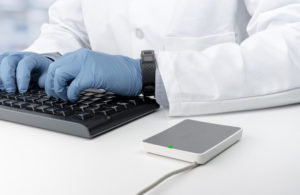
Image courtesy of Nymi
The pandemic has amplified the pressure pharmaceutical companies face to improve operational performance while also forcing them to accelerate innovation, clinical trials and production. All of this requires employees to work as efficiently as possible.
Technology is available to meet these needs while also helping pharma companies respond to new worker safety challenges. Within pharma facilities, workers want to touch fewer surfaces and minimize their interactions. Accomplishing these goals requires deploying hands-free systems, conducting self-health attestations before shifts, and enforcing social distancing and contact tracing procedures.
Efficiency and safety are not mutually exclusive goals. Businesses that fall short in these areas risk their brand reputation, bottom line and employees’ lives. While many companies previously addressed individual challenges using point solutions, this approach can be costly, difficult to maintain and pose interoperability challenges.
Luckily, innovative connected worker technologies are entering manufacturing floors to help meet these business priorities. When investing in such a new technology or tool, however, it’s essential to focus on a scalable and flexible platform that supports and protects employees without disrupting their daily activities.
Technologies that minimize administrative tasks
Pharmaceutical manufacturing workers must comply with quality and security procedures when, for instance, signing documents or accessing restricted areas. Authentication methods such as password entry or pen-and-paper signatures are often required hundreds of times per day. While vital, these steps have slowed employees down from completing the most important task of safely and efficiently shipping products. In addition to the efficiency drag, passwords and signatures leave pharmaceutical companies exposed to cybersecurity risks.
To cope with these challenges, many companies use wearable devices that can continuously authenticate users and grant access to critical systems. For example, a manager going from an office onto the production floor typically needs to enter a code and provide a signature to timestamp their entry. With workplace wearables, the manager could simply tap a wristband and, almost instantly, a secure transaction would complete the task and be logged. Biometric identification features in the wristband prevent another individual in the building from authenticating with the device. This wristband-based authentication process is faster and easier while improving data integrity.
Promoting employee safety and health into the future
Pharmaceutical manufacturing facilities are traditionally active environments with employees working in proximity. This fact poses pandemic-related health risks for companies that fail to adapt. Some companies are already providing PPE surpluses to keep employees safe. Many are also looking to adopt technologies to proactively enforce social distancing regulations and support contact tracing when needed.
When identifying tools that will seamlessly fit within a workers’ day, it’s essential to invest in those that don’t add an operational burden. It’s also critical to find technologies that work underneath personal protective equipment.
Using hands-free connected worker tools that automatically and continuously verify workers’ identities, companies can understand the general proximity between two wearable devices and gently remind each individual that they need to stay apart. In addition to conditioning active workers to be more aware of social distancing protocols, this type of technology can also provide managers with advanced visibility and analytics for contact tracing. If an employee tests positive for COVID-19, companies must prioritize the safety of their entire workforce without completely pausing operations. This type of technology could provide accurate insights into who came into contact with whom and when, helping track the virus’s spread.
To stave off future disruptions, careful planning is needed. Protocols for PPE, touchless access and signatures, social distancing and contact tracing will likely be required long after there is a treatment for COVID-19. However, it is also essential to think about the long game and deploy technologies that will be useful for other business needs. For example, the same proximity capabilities used for social distancing with another human can also ensure safe distancing with heavy equipment or robots within a plant. Additionally, pharma companies can use this technology to alert workers that there is an incident at the facility.
Ultimately, COVID-19 has exacerbated efficiency and safety issues that have long existed in our industry. As plant managers work to return productivity to pre-COVID-19 levels, they must prioritize balancing overall worker efficiency while managing strict guidelines for a healthy workplace. This requires investments in smarter tools that ease the burden on workers while improving safety, security and data integrity. It’s also ineffective to think just about short-term solutions. For digital transformation to support long-term business continuity, it’s critical to deploy technologies today that have the flexibility to meet future needs.
Chris Sullivan is the chief executive officer of Nymi.